Ultrabook Head to Head: Acer Aspire S3 vs. ASUS UX31E
by Jarred Walton & Manveer Wasson on December 21, 2011 5:40 AM ESTUltrabook Application Performance
We’ve really covered most everything that matters, as the core hardware is very similar. By this time you should have a good idea which ultrabook (if any) is right for you, but we still have benchmarks to run. We’ll start with our usual application performance metrics, skip the gaming tests (HD 3000 is sufficient for entry level gaming and that’s about it), and then looks at the battery life and display metrics. All of the ultrabooks we’ve tested have SSDs for storage, which really helps the general application performance; keep in mind that models that opt for an SSD+HDD hybrid solution (like the less expensive Acer S3) won’t have nearly the overall responsiveness. We’d just as soon Intel revise the ultrabook spec to mandate SSD storage only for the OS and apps (e.g. at least a 60GB SSD), but that ship has unfortunately sailed. Anyway, let’s hit the charts, starting with PCMark 7.
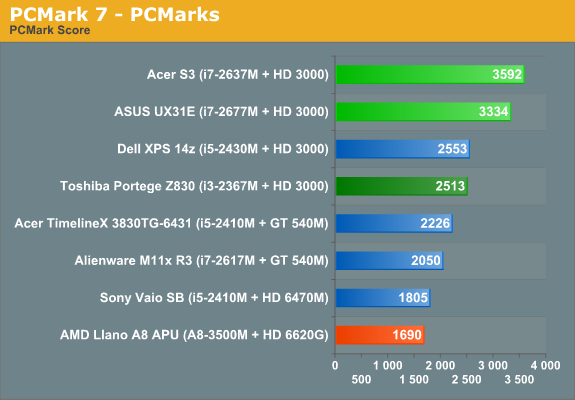

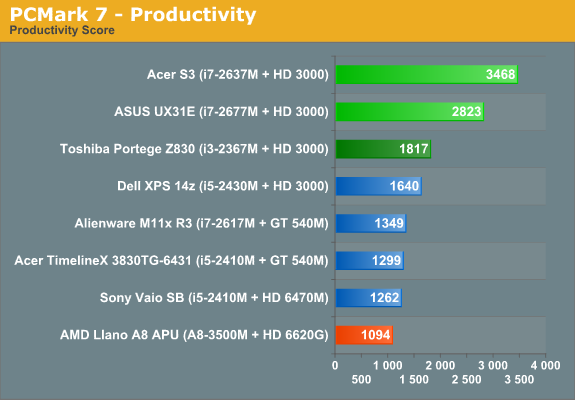
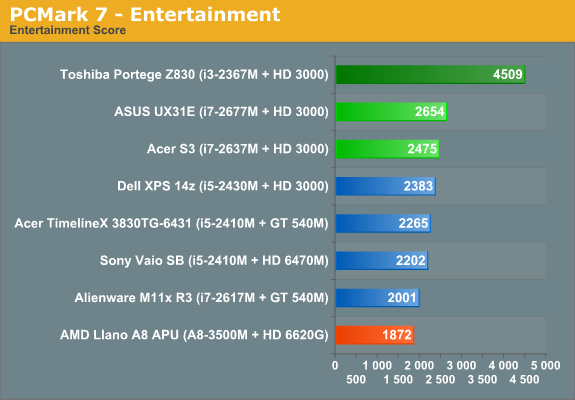

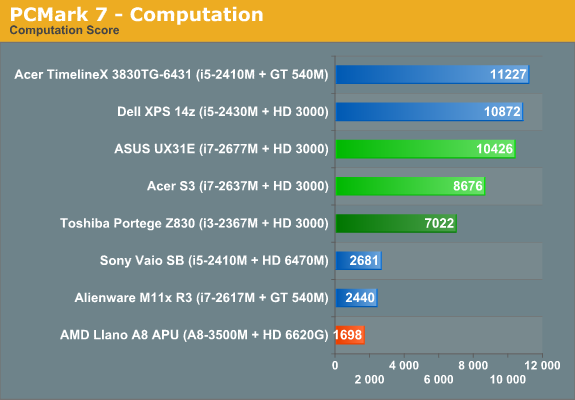
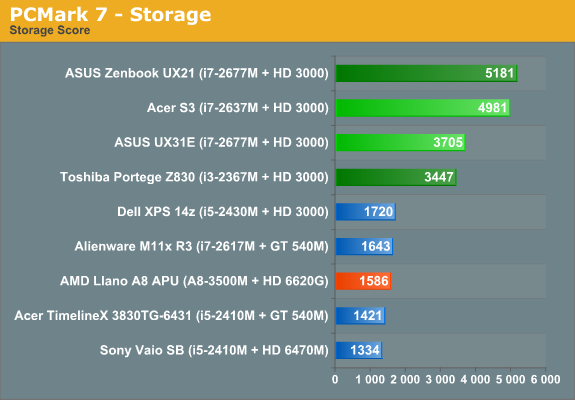
Our full set of PCMark 7 results is the most compelling view of using an ultrabook. They don’t have the raw compute power of a quad-core notebook or even a non-ULV Core i5, but for most tasks the ULV processors are plenty fast. Windows boots and shuts down very quickly, launching multiple applications simultaneously doesn’t grind performance to a halt, and even better you can mostly avoid the long-term performance degradation that usually comes with Windows and conventional hard drives. There are a couple other items of interest to point out with these results. First, the Micron C400 is clearly faster than the SanDisk U100 SSD; this manifests in many of the benchmarks, but the Storage suite in particular shows just how much of a difference there is. Also note that the UX21E we tested had a SandForce 2200 based SSD, and that’s why it also scores well despite only having 128GB (e.g. fewer NAND die). The other item to point out is that the ASUS shipped with newer Intel graphics drivers; usually such things don’t matter much, but here the updated drivers really boost the Quick Sync performance (and thus the Computation score) as well as some of the 3DMark results we’ll see below. Let’s hit the rest of the application benchmarks before we summarize things.
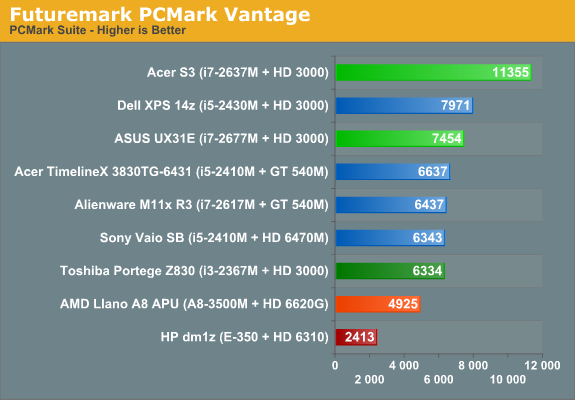
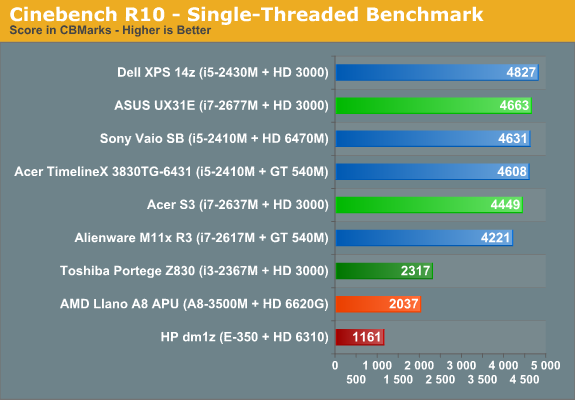
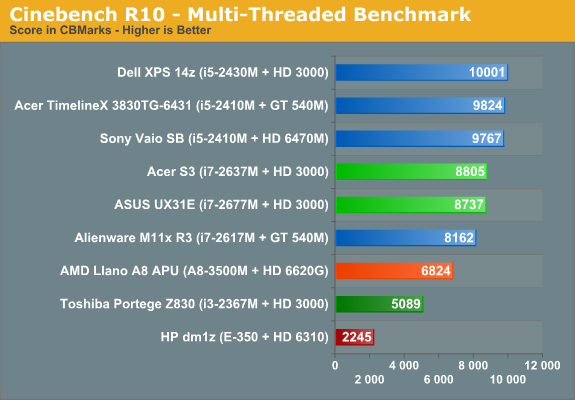
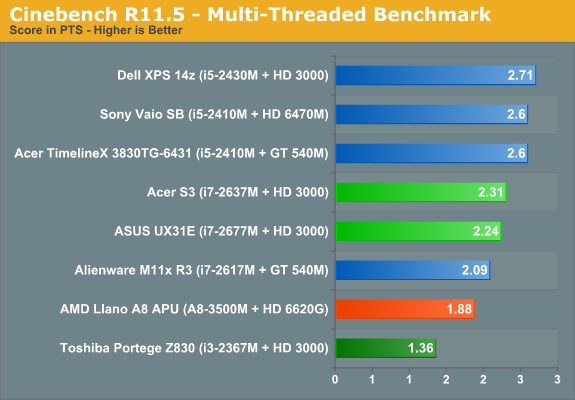
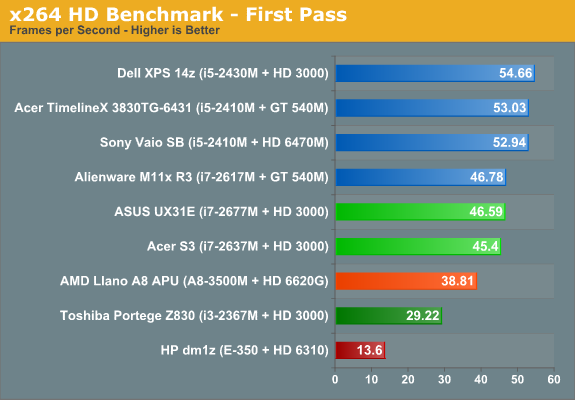
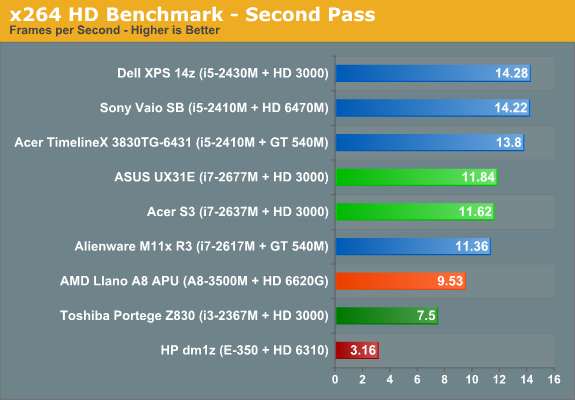
Once we get away from the SSD-centric tests like PCMark (Vantage appears particularly unkind to the SanDisk U100), performance falls out where you’d expect. With the high Turbo Boost modes available on the i7 ULV processors, the S3 and UX31E can actually give the 35W TDP Core i5 parts a run for the money, but if you put a sustained load on the CPU (which most of these tests do) you’ll see the clock speeds drop after the first 30-45 seconds. Generally speaking, even the OEM i5-2410M/2430M are faster than the i7-2677M in most tests, but that’s fine as the ULV parts are at least close and they still use half the power at full load. Taking a look at the AMD side of things, we’ll just skip Brazos—it’s there for reference, and since it ships in 13.3” laptops it’s a fair addition for low-power laptops, albeit one that costs half as much as an ultrabook. Llano on the other hand still comes out okay in performance comparisons; where it was clearly faster than the i3-2367M ULV part in multi-threaded scenarios, the Core i7 ULV parts regain the lead, but that’s not the entire story.
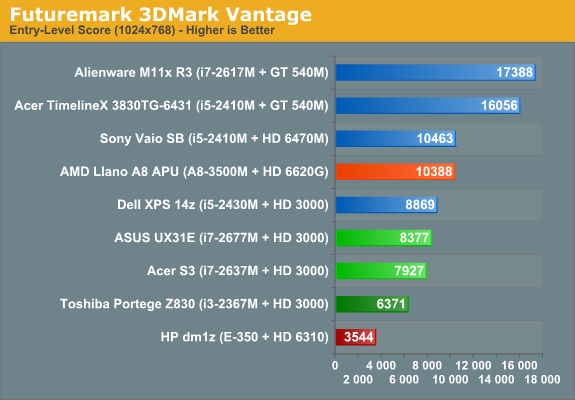
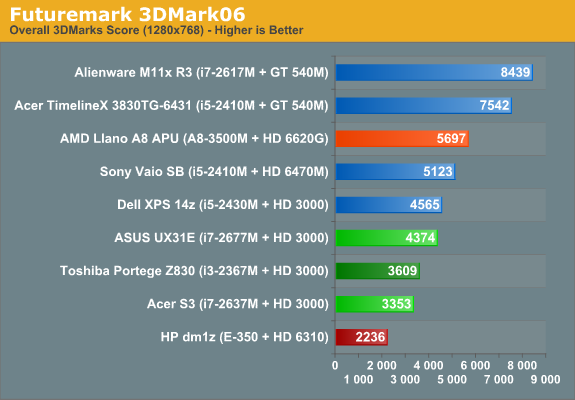
Rounding things out with 3DMark, the three ultrabooks place at the bottom of the charts. They’re faster than the E-350 IGP, but that part competes in a completely different price range so that’s okay; Llano on the other hand puts paid to anything without a discrete GPU. We’d still like to see A8-series APUs in laptops costing under $600, and Llano uses more power than the ULV chips and goes into thicker, better cooled laptops. Still, it’s a great budget laptop part if you care more about graphics than CPU intensive tasks. Give it an SSD for storage and it will hang with the ULV parts in many of the other tests as well.










81 Comments
View All Comments
Toshio - Wednesday, December 21, 2011 - link
Anyway, I'm very sorry if I was harsh in the earlier posts, didn't really mean to. Perhaps it's my bad experience with other sites being so biased towards their main sponsors (not only Apple). Thanks for for your patience whatsoever.Paedric - Wednesday, December 21, 2011 - link
I'm not a big Apple fan (to say the least), but no one can deny that they are the leader in this market for now (if we forget the OS).It would be stupid not to compare those units with the Apple one, because reviews means practically nothing on their own. You have to compare products to see which one is better.
It's the same situation in the tablet market, the Ipad 2 is the leader. Doing a review of an Android device that is only compared to other Android tablets would be really narrow minded.
pdjblum - Wednesday, December 21, 2011 - link
Ditto that.SilthDraeth - Wednesday, December 21, 2011 - link
Sorry if it were mentioned, but what is the resolution for the Asus display? All I read is contrast ratio, and the line"Asus chose the former" which was alluding to the high resolution brighter display vs lower resolution higher contrast...
But I didn't see you mention the resolution. I did see you mention it for the Macbook Air.
Thanks.
Romberry - Wednesday, December 21, 2011 - link
1600 x 900bji - Wednesday, December 21, 2011 - link
As with all Anandtech laptop reviews, I go straight to the display resolution section. If it says 1366x768, I don't read another word. Next article please.JarredWalton - Wednesday, December 21, 2011 - link
You might want to look at the ASUS then, as it's 1600x900.Shadowmaster625 - Wednesday, December 21, 2011 - link
Please discuss docking options, especially for a whole workstation with two monitors, wired ethernet, several usb devices, and external speakers. Can it all be done over one usb 3.0 port?ccd1 - Wednesday, December 21, 2011 - link
Targus is coming out (or has come out) with a USB 3.0 docking station. The device is a little pricey ($179). Also, the reviews of their USB 2.0 docking station were mixed. Might be a nice device for Anandtech to review.Solandri - Wednesday, December 21, 2011 - link
What's special about the Portege Z830 which lets its i3 rise up and spank the i5s and i7s at that particular benchmark?